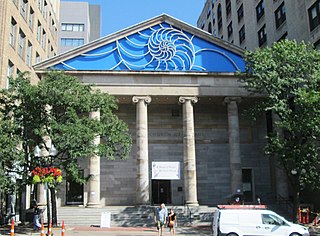
The Cathedral Church of St. Paul, Boston is the historic cathedral church of the Episcopal Diocese of Massachusetts. Located at 138 Tremont Street near Downtown Crossing, directly across from Boston Common and Park Street Station, the cathedral is adjacent to the diocesan offices. The acting dean of the cathedral was the Rev. Nancy Gossling, following the retirement of the Rev. Jep Streit in February 2017. On April 22, 2018, Amy E McCreath was named the ninth dean and first female dean of the Cathedral Church of St Paul, and was installed as dean on September 29, 2018. The church, designed by Alexander Parris and Solomon Willard and built in 1819, was the first Greek Revival church in New England, and was designated a National Historic Landmark in 1970 for its architectural significance.

Horatio Potter, was an educator and the sixth bishop of the Episcopal Diocese of New York.

The Episcopal Diocese of Bethlehem covers fourteen counties in Pennsylvania to the north and west of Philadelphia. The current bishop, the Rt. Rev. Kevin D. Nichols, was elected as Bishop on April 28, 2018, and consecrated on September 15, 2018. The cathedral is the Cathedral Church of the Nativity in Bethlehem. The pro-Cathedral is St. Stephen's, Wilkes-Barre. Between the 1970s and the 2020s, the diocese has been a major epicenter for clerical sexual abuse claims regarding priests, youth leaders, and organists, with multiple thousands of criminal charges against clergy and lay employees.

St. Paul's Episcopal Church, built in 1871, is an historic Episcopal church located at 7 Court Place at York Street in Newport, Kentucky, in the United States. On November 25, 1980 it was added to the National Register of Historic Places.

St. Mary's Episcopal Cathedral, designed by Memphis architect Bayard Snowden Cairns, located near downtown Memphis, Tennessee, is the cathedral church of the Episcopal Diocese of West Tennessee and the former cathedral of the old statewide Episcopal Diocese of Tennessee.

The Episcopal Diocese of Nebraska is the diocese of the Episcopal Church in the United States of America with jurisdiction over the state of Nebraska. It is in Province VI. Its cathedral, Trinity Episcopal Cathedral, is in Omaha, as are the diocese's offices. As of 2019, the diocese contains 52 congregations and 7,096 members. Average Sunday attendance is approximately 2,418 across the diocese.
Edward Tuckerman Potter was an American architect best known for designing the 1871 Mark Twain House in Hartford, Connecticut. With his half-brother William Appleton Potter, he also designed Nott Memorial Hall (1858–79) at his alma mater, Union College, Schenectady, New York. Both the Mark Twain House and Nott Memorial Hall are National Historic Landmarks.
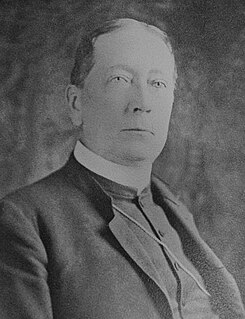
Cleland Kinloch Nelson was the Third Bishop of the U.S. state of Georgia and the first bishop of the Episcopal Diocese of Atlanta. Nelson was the 160th bishop of the Episcopal Church in the United States of America (ECUSA).
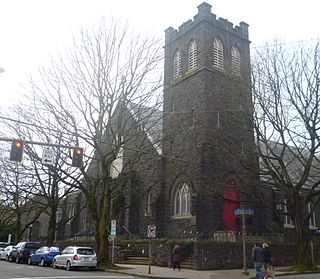
Trinity Episcopal Cathedral in Portland, Oregon is a progressive Episcopal congregation and the seat of the Episcopal Diocese of Oregon of The Episcopal Church. The cathedral is located at 147 NW 19th Avenue in Portland, Oregon, in the Northwest District.
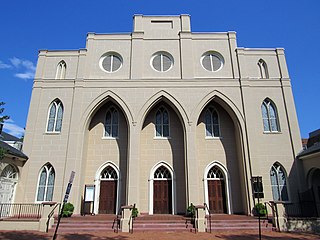
St. Paul's Episcopal Church is an historic Episcopal church in the Anglican Communion located in the Old Town area of Alexandria, Virginia. The church, consecrated in 1818, was designed by Benjamin Latrobe, the second architect of the United States Capitol. It is one of the few buildings designed by Latrobe in a Gothic style and one of the earliest examples of Gothic Revival architecture in the United States. The church was placed on the National Register of Historic Places in 1985. During the year 2009, St. Paul's Episcopal Church celebrated the bicentennial of its founding.
Robert Deane Rowley, Jr. was the seventh bishop of the Episcopal Diocese of Northwestern Pennsylvania.
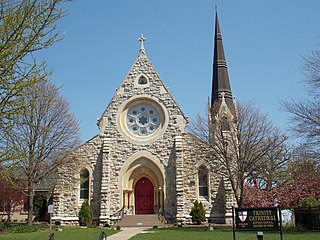
Trinity Episcopal Cathedral, formerly known as Grace Cathedral, is the historic cathedral in the Diocese of Iowa. The cathedral is located on the bluff overlooking Downtown Davenport, Iowa, United States. Completed in 1873, Trinity is one of the oldest cathedrals in the Episcopal Church in the United States. It was individually listed on the National Register of Historic Places in 1974. In 1983 the cathedral was included as a contributing property in the College Square Historic District, which is also listed on the National Register.

The Federal Street Theatre (1793–1852), also known as the Boston Theatre, was located at the corner of Federal and Franklin streets in Boston, Massachusetts, United States. It was "the first building erected purposely for theatrical entertainments in the town of Boston."
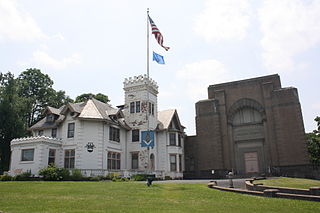
Fountain Hill Historic District is a national historic district located at Bethlehem, Lehigh County and Northampton County, Pennsylvania. The district includes 44 contributing buildings and 1 contributing structure. The buildings include elaborate, architecturally distinctive mansions, smaller managers' and merchants' dwellings, and public church buildings. The mansions are the focus of the district and include the Linderman / Schwab Mansion, Robert Sayre House, and Elisha Packer Wilbur Mansion. Notable non-residential buildings include the Masonic Temple and Nativity Episcopal Cathedral. The Hill to Hill Bridge is also included in the district. Located in the district is the separately listed Lehigh Valley Railroad Headquarters Building.
Lloyd Edward Gressle was an American Anglican bishop who served as the Bishop of Bethlehem from 1971 to 1983.

Trinity Episcopal Cathedral is an Episcopal cathedral located in Trenton, New Jersey, United States. It is the seat of the Diocese of New Jersey.
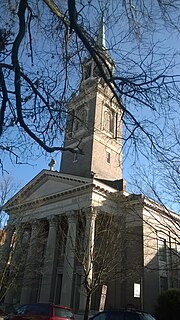
St. James's Episcopal Church is the third oldest Episcopal congregation in Richmond, Virginia. Only the older St. John's Episcopal Church on Church Hill also remains an active congregation.
Peter David Eaton is the fourth and current bishop of the Episcopal Diocese of Southeast Florida.
Frederick John Warnecke was bishop of the Episcopal Diocese of Bethlehem from 1954 to 1971.
Kevin Donnelly Nichols is the ninth and current bishop of the Episcopal Diocese of Bethlehem.


























